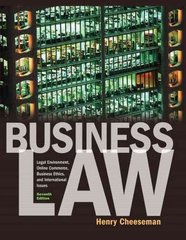Question
Consider an excise tax imposed on daily parking charges in the downtown of a small city. Before the imposition of the tax, equilibrium price and
Consider an excise tax imposed on daily parking charges in the downtown of a small city. Before the imposition of the tax, equilibrium price and quantity are $15 and 100 cars parked. (P = $15, Q = 100). The city government imposes a tax of $3 per car parked per day. Market equilibrium adjusts to P = $18 and Q = 100. Which of the following statements about the burden of the tax is correct?
Price elasticity of demand is 1 and therefore the entire burden of the tax falls on the seller
Elasticity of supply is 1 and therefore the entire burden of the tax falls on the seller.
Price elasticity of supply is 0 and therefore the entire burden of the tax falls on the consumer.
The burden of the tax is shared equally by the seller and the consumer.
Elasticity of demand is 0 and therefore the entire burden of the tax falls on the consumer.
Suppose the price elasticity of demand for good X is 1.5. If household income increases by 25%, ceteris paribus, what is the change in quantity demanded for good X?
a 3.75% increase in quantity demanded
a 0.375% increase in quantity demanded
a 37.5% increase in quantity demanded
no change in quantity demanded
There is not enough information to answer this question.
f the income elasticity of demand for a good is 0.75, a 25% increase in income results in
an 18.75% increase in quantity demanded.
a 3% decrease in quantity demanded.
a 0.1875% increase in quantity demanded.
a 3% increase in quantity demanded.
There is not enough information to answer.
Suppose a decrease in world demand for potash (used in the production of fertilizer) decreases the price from $400 per tonne to $240 per tonne. Annual Canadian production decreases from 12 million tonnes to 8 million tonnes. What is the elasticity of supply of Canadian potash?
0.75
0.8
1.0
0.4
1.25
If the demand for some good fluctuates, but the supply curve is stable, then which of the following combinations would generally yield the greatest quantity fluctuations?
small demand fluctuations and elastic supply
small demand fluctuations and inelastic supply
large demand fluctuations and inelastic supply
small demand fluctuations and unit elastic supply
large demand fluctuations and elastic supply
Step by Step Solution
There are 3 Steps involved in it
Step: 1

Get Instant Access to Expert-Tailored Solutions
See step-by-step solutions with expert insights and AI powered tools for academic success
Step: 2

Step: 3

Ace Your Homework with AI
Get the answers you need in no time with our AI-driven, step-by-step assistance
Get Started


